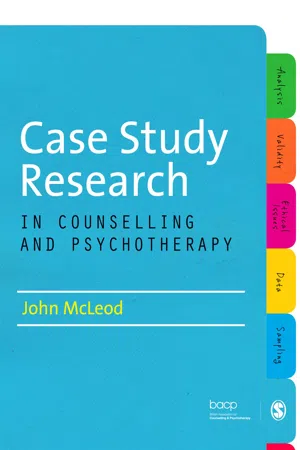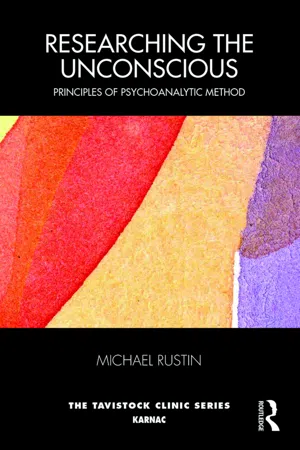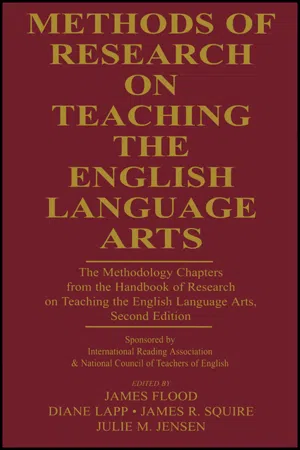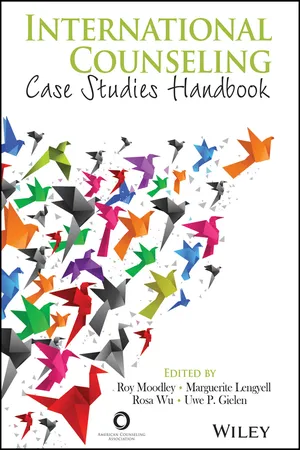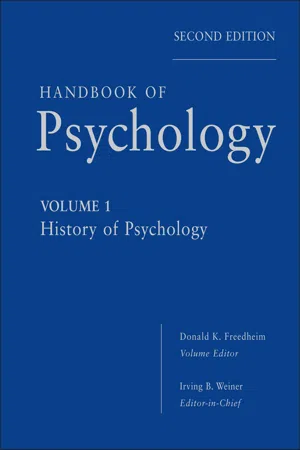Psychology
Case Studies Psychology
Case studies in psychology involve in-depth analysis of individual cases to understand behavior, mental processes, and psychological disorders. Researchers use various methods such as interviews, observations, and psychological tests to gather detailed information. These studies provide valuable insights into the complexities of human behavior and contribute to the development of psychological theories and interventions.
Written by Perlego with AI-assistance
Related key terms
9 Key excerpts on "Case Studies Psychology"
- eBook - ePub
- Gershon Tenenbaum, Robert C. Eklund(Authors)
- 2020(Publication Date)
- Wiley(Publisher)
This chapter aims at developing a broader holistic understanding of case studies as they relate to sport and exercise psychology. The chapter clarifies the essence of case studies, beginning with defining the case study term. The chapter then considers the use of case study approaches more broadly in psychology, before explicitly outlining the differences that exist between professional practice and research case studies. Finally, the chapter explores the development of case studies for publication.Defining a Case
Before considering what the study of a specific case involves, it is imperative to clarify what a “case” refers to. At a broad level, a case has been described as a phenomenon specific in time and space. Miles and Huberman (1994 ) specifically described a case to be “a phenomenon of some sort occurring in a bounded context. The case is, in effect, your unit of analysis” (p. 25). Indeed, if utilizing a case study approach in a research context, the clarity of the case itself has been highlighted as being of paramount importance. As a result, clearly articulating the limits of the case are crucial. In support of this point, Stake (2000 ) highlighted that, “as a form of research, case studies are defined by interest in individual cases, not by the methods of inquiry used” (p. 445). Also, Johnsson (2003 ), in reviewing case study approaches in psychology, broadly suggested that a case study should have a “case” that is the object of study, and that is the starting point for the research. Specific criteria regarding the case include that it should be: (1) be a complex functioning unit, (2) be investigated in its natural context with a multitude of methods, and (3) be contemporary. An important aspect of determining the case is to identify boundaries regarding the scope of the case to ensure the evaluation remains focused. Indeed, Hodge and Sharp (2017 ) highlighted that a case study is about the boundedness of the case, and not just an in‐depth study. Building on this point, Yin (2009 ) stated that the criterion of boundedness is the key defining characteristic of a case study. The bounded nature of a case relates to (1) exclusive membership of a bounded group, (2) delineated location/place of existence, and (3) a delimited time frame (Hodge & Sharp, 2017 ). Both Yin (2014 ) and Stake (1995 ) suggested setting boundaries for a case to prevent “an explosion” from taking place in terms of the data collected. This bounding of the case could be achieved by (1) clearly determining the time and place (Hodge & Sharp, 2017 ), (2) Clarifying the time to be investigated and activities to be assessed (Stake, 1995 ), and (3) Clearly defining the context in which the case is being explored (Miles & Huberman, 1994 - John McLeod(Author)
- 2010(Publication Date)
- SAGE Publications Ltd(Publisher)
complex processes. This feature of case study research in counselling and psychotherapy is clearly attractive and valuable to many researchers, since many readers of large-sample extensive studies bemoan the fact that these studies usually over-simplify what happens in therapy. On the other hand, complexity also presents a challenge or danger for researchers and research audiences – too much complexity can become chaotic and meaningless.Contextuality as an essential feature of case study research
A case study involves investigating an entity within its natural context. This approach can be compared with what happens in laboratory experiments or in analogue studies in counselling and psychotherapy, in which a controlled situation is created in order to make it possible to test hypotheses about cause–effect linkages. In surveys, large-scale naturalistic studies and randomized trials, the investigation may be based in a real-world context, but there is typically little information collected or reported about contextual factors. Yin (2009: 18) defines a case study as:…an empirical inquiry that investigates a contemporary phenomenon in depth and within its real-life context, especially when the boundaries between phenomenon and context are not clearly evident.The key idea here is that, in any intensive study of a specific case, the closer the ‘case’ is examined, the less certainty there is about the boundaries of the case, in terms of information that may be relevant to an understanding of the case. For example, in counselling and psychotherapy case study research, there often arise questions concerning the therapeutic impact of events and experiences that were not part of the actual therapy approach that was delivered. There are also many theoretically and practically interesting questions about when the case begins and ends (At the final therapy session? Six months following the final therapy session?). In analysing the factors that influenced outcome in a specific therapy case, it may become apparent that improvements in the client’s condition may have been due to getting a new job, or to conversations with the assistant who carried out research interviews. Because the aim is to arrive at a comprehensive understanding of a single case, by creating a rich data set, many of these ‘fuzzy boundary’ factors are observed and recorded, and become relevant in the analysis. By contrast, in studies with large numbers of participants, there is no scope for such factors to become part of the data set, or to play a role in analysis. In some therapy case studies, the researcher or author makes a specific effort to collect information about the context in which the therapy takes place. However, even when the researcher or author does not prioritise contextuality, the fact that there is more space in a case study to describe the client, the therapist, and therapy, means that readers are provided with a more in-depth understanding of the context of the case.- eBook - ePub
Companion Encyclopedia of Psychology
Volume One
- Andrew M. Colman(Author)
- 2018(Publication Date)
- Routledge(Publisher)
Psychology repudiates all attempts to divide its subject matter into watertight compartments, so some seepage between chapters and even between sections has been condoned in this encyclopedia, and unsurprisingly a section devoted to "special topics" turned out to be necessary because certain obviously important topics refused to fit into any of the other sections. Furthermore, research methods and statistics transcend the classification outlined in the previous paragraph, and it would be inappropriate to classify them as "special topics" because they could hardly be more general, but they are integral to the discipline and are taught in all reputable degree courses, so a further section in this encyclopedia is devoted to them. And for the sake of completeness, a final section deals with the professions of psychology.Research Methods
Research in psychology, as in any other science, always begins with a question that needs answering. The question may arise from the natural curiosity of the researcher, from a formal theory that generates a testable prediction, or from something puzzling thrown up by the findings of previous research. Provided that it relates to behaviour or mental experience and is an empirical question that can be tackled by collecting objective evidence, it is a legitimate problem for psychological research. What follows is a brief outline of the main research methods used in psychology (for a more extended discussion along the same lines, see Colman, 1988, chap. 4).Case studies
A case study is a relatively primitive research method. In psychology, it involves a detailed investigation of a single individual, or occasionally a single social organization. Research of this kind is common in abnormal psychology (see section 10) and comparatively rare in other branches of the discipline. The data reported in case studies may be derived from interviews, diaries, case histories, medical records, questionnaires and other psychometric tests, or direct observations of behaviour. The findings of case studies can be interesting and valuable, but they often suffer from problems of generalizability, because one individual's response to a particular treatment (for example) is not necessarily the same as another's. The accumulation of evidence from a number of case studies, especially if they are reported by independent investigators, can sometimes mitigate this problem. (For more detail on case studies, see chapter 12.5, Francis C. Dane.) - John McLeod(Author)
- 2011(Publication Date)
- SAGE Publications Ltd(Publisher)
12Qualitative case studies
There is a complex relationship between qualitative research and the use of case studies. A case study is the analysis of a single example of an entity that exists within the social world. For example, within the field of counselling and psychotherapy research, a ‘case’ may be a clinic or counselling agency, a larger social unit (for instance, a case study of the development of counselling in Shetland; Kirkwood 2000) or the whole of the therapy received by a client, couple or family. The distinctive value of a case study approach is that it can be used to analyse the complex interaction of factors within a single case (Yin 2003). ‘Cases’ turn up in many different ways within qualitative research. Some qualitative methodologies, such as IPA and ideal type analysis, place great emphasis on treating each research participant as a discrete case, even if the data are ultimately merged into a wider cross-case, analysis. Many qualitative researchers punctuate their analyses of data collected from a larger set of informants, with brief case vignettes that are used to illustrate and exemplify broader themes or categories. Finally, qualitative studies that involve intensive examination of talk, conversation and narrative tend to be based in single examples. However, these are not case studies, but studies that make use of cases; a case study is a form of inquiry that seeks to make sense of all aspects of a case, as a thing in itself.Case study research is important in counselling and psychotherapy, as well as in any area of professional activity, such as medicine, teaching, social work or management, that requires a capacity to deal with cases. The development of a body of credible case analyses represents one of the fundamental ways in which professional knowledge is documented and transmitted. Within the field of counselling and psychotherapy there has been a recent resurgence of interest in case study research, arising from an appreciation of the limitations of large-sample studies (whether qualitative or quantitative) in relation to the production of practical knowledge (Fishman 1999).- eBook - ePub
Researching the Unconscious
Principles of Psychoanalytic Method
- Michael Rustin(Author)
- 2019(Publication Date)
- Routledge(Publisher)
CHAPTER SEVEN Case-study methods in psychoanalysisT he psychoanalytic field is often criticized for its reliance on clinical case studies as its primary research method. If psychoanalysis is to establish its place among the mainstream psychological sciences, it has been argued, it needs to abandon its reliance on its traditional approach to knowledge generation and adopt methods, such as the randomized double-blind controlled trial, that are more likely to achieve scientific respectability.But why, if case studies are of such limited value in providing statistical evidence of the effects of psychoanalytic treatments, have they nevertheless proved so productive in generating new knowledge and understanding over the entire history of psychoanalysis? To understand this, it is useful to understand the larger place of case-study methods in scientific research.Contexts of case study researchThe fields in which these methods have proved most fertile in the generation of knowledge share certain characteristics, as a substantial literature explains (Byrne & Ragin, 2012; Ragin & Becker, 2010; Smith, Harré, & Van Langenhove, 1995; Stake, 1994). These are fields in which the objects of study are complex in the interrelationships between their component elements. They have a high degree of specificity and therefore difference from other apparently similar objects of study. They are often subject to substantial change and variation over time.Mostly it is in the biological and especially the human sciences where such complex and singular entities are objects of investigation, because it is in these fields that interest in differences between objects of study is paramount. The unending process of “speciation” that Darwin noted to be the outcome of natural selection has given rise to innumerable different species, each living in its particular ecological niche. Although there are many attributes common to different species, in their genetic structure, anatomy, behaviour patterns, and so on, species are, by definition, distinct from one another (they are defined by their capacity to reproduce only within their own kind), and they evolve different modes of adaptation and survival. For this reason, the study of particular instances of a species in its environment has remained an illuminating kind of scientific inquiry. - eBook - ePub
Methods of Research on Teaching the English Language Arts
The Methodology Chapters From the Handbook of Research on Teaching the English Language Arts, Sponsored by International Reading Association & National Council of Teachers of English
- James Flood, Diane Lapp, James R. Squire, Julie Jensen(Authors)
- 2005(Publication Date)
- Routledge(Publisher)
CHAPTER 5Case Studies: Placing Literacy Phenomena Within Their Actual Context
June BirnbaumJanet Emig
Rutgers University
Douglas Fisher
San Diego State University
Within the past 30 years, case study as a mode of inquiry has gained increased credibility in English language arts research. A scan of the literature reveals hundreds of inquiries in which researchers recount how children acquire and develop language, as well as hundreds of others that characterize their histories and processes as speakers, listeners, writers, and readers. Still other studies have examined individual issues, texts, concepts, programs, and curricula. This chapter provides an overview of case study inquiry, the history of case study research, the use of case studies in literacy research, and concludes with a discussion of trends and future directions.CASE STUDY INQUIRY
Although traditional, quantitative approaches to measurement are appropriate for evaluating activities and behaviors that can be counted or measured, they are less effective in analyzing complex, multidimensional characteristics of a phenomenon. For this reason, qualitative approaches such as observations, open-ended interviews, and case studies are often selected as a way to situate findings within a specific context. The advantage of a qualitative approach is that it allows a more in-depth exploration of the research questions. This chapter focuses on one specific type of qualitative inquiry, case studies.Case study is defined here, following Yin (1981), as an empirical study that investigates a contemporary phenomenon within its real-life context when the boundaries between phenomenon and context are not clearly evident and when multiple sources of evidence are used. In addition, to qualify as a case study, the data must be in some way representative of the phenomenon under scrutiny. As Shulman (1986) cautions, an exclusive description of an individual or event does not qualify as a case study. - eBook - ePub
Researching, Reflecting and Writing about Work
Guidance on Training Course Assignments and Research for Psychotherapists and Counsellors
- Fiona Gardner, Steven J. Coombs(Authors)
- 2009(Publication Date)
- Routledge(Publisher)
Check again that the structure you have now written up is logical and that the ideas are clearly presented to the reader. Check that you haven’t overdone the adjectives and make sure that you have covered all the criteria. When it is ready ask someone else, if possible a tutor or supervisor, to read the paper and comment. Make any necessary changes before submitting the required number of copies in the way that is asked for, and then you can finally relax.Part 2: The technicalities of using a case study as the methodology for research
The term ‘case study’ is clearly linked to the idea of a case history. It was Freud who commented on his case studies as like reading short stories, and lacking the serious stamp of science. But although the case study may still include qualities of the literary genre, it has developed into a sophisticated research methodology that ‘is done in conformity with science’s goals and methods’ (Campbell, preface to Yin 2003: x). Case studies are chosen as a highly appropriate research paradigm for dealing with therapeutic subject matter that involves relational research, and for when social researchers want to work within a real-life context and validate their evidence drawn from social practice.Different researchers and theorists, often from social science or psychology backgrounds, have identified diverse forms of case study methodology. It is now generally understood as a generic term that covers a grouping of research methods with the shared basis of the ‘decision to focus an inquiry around an instance’ (Nisbett and Watt 1984: 74). This ‘instance’, or real-life ‘critical learning field event’, can be identified as a piece of qualitative research evidence recorded from any particular naturally occurring phenomenon during therapeutic work, or it could be an observation of client characteristics, or even elicited as an observational theory about the work and the therapeutic process. Qualitative data can therefore be gathered from an individual or a group critical learning field event via direct observation and further critical professional reflection on the practice experienced. - eBook - ePub
International Counseling
Case Studies Handbook
- Roy Moodley, Marguerite Lengyell, Rosa Wu, Uwe P. Gielen(Authors)
- 2015(Publication Date)
- American Counseling Association(Publisher)
case study based practice and training in counseling and psychotherapy. This cumulative clinical knowledge within a clinician is transferrable not only to his or her other cases but also to fellow clinicians’ cases through case conferences, workshops, and/or publications. Therefore, the case study is beyond a clinician’s hunches or personal clinical wisdom. In reality, it is an inductive, cumulative, and systemic inquiry of human existence and sufferings—a scientific, empirical approach (Lee, Mishna, & Brennenstuhl, 2010). The active pursuit of this wealth of clinical knowledge truly is an accountable practice for a service provider and a necessary quality, especially when serving clients with diverse cultural backgrounds in a global world.Lee et al. (2010) proposed ways to critically evaluate the case study in clinical practice and proposed case study evaluation criteria. By incorporating these criteria as well as other findings from cross-cultural clinical practice research (Lee, 2010; Lee & Bhuyan, 2013; Lee & Horvath, 2013, 2014), I delineate in this chapter ways to use and maximize a case study approach that is situated in a global context for clinicians in their own local community.Intensive Investigation of a Case Embedded in Real-Life Context
A main purpose of case study is the intensive investigation of the client system/case under study in naturalistic (not controlled) real contexts, while examining multiple variables using multiple sources of evidence with the aim of providing in-depth rich information (Lee et al., 2010). Providing a thick description of the client in context considering ‘‘contextual inclusiveness’’ (Bergen & While, 2000, p. 932) or ‘‘the proximity to reality’’ (Flyvbjerg, 2006, p. 236) then assists mental health practitioners to “conceptually decide to what extent the case as described” (Fishman, 2005, p. 17) can be applicable to their own cases. Although not exhaustive, the following list is a compilation of areas to consider in developing a rich case study description: the case selection, collection points of clinical information, source of clinical information, intervention procedures and ingredients, interpretation of clinical information, and clients’ feedback. - eBook - ePub
- (Author)
- 2012(Publication Date)
- Wiley(Publisher)
Journal of Abnormal and Social Psychology after Prince offered to donate the journal, once oriented primarily toward practicing psychiatrists, to the American Psychological Association in 1925 (G. W. Allport, 1938). Once social psychologist Henry T. Moore of Dartmouth replaced Floyd Allport as cooperating editor in 1925, the practice of publishing case studies declined dramatically, resembling publication trends in mainstream psychological journals where the proportion of reports featuring individual data had been declining steadily since the 1910s (Shermer, 1985). Under Moore, who selected articles according to “psychological” standards, the proportion of empirical papers based on the study of individual cases dropped from an average of 65%, under Floyd Allport (who had worked closely with Prince), to 30% (see Shermer, 1985): “Their place was taken by statistical studies based on group data” (Danziger, 1990, p. 165). (Moore himself conducted group studies using psychometric tests; see, e.g., Moore, 1925).By the late 1920s, psychologists (e.g., G. W. Allport & Vernon, 1930; Murphy & Murphy, 1931) and sociologists (e.g., Bernard, 1932; Young, 1928) reviewing the personality literature were explicitly identifying the psychometric approach with psychology, and life histories and case studies with sociology and psychiatry. Although several of these authors expressed positive views of studies of individual lives, their recommendations that psychologists explore such methods appear to have had little impact (see, e.g., Parker, 1991). Like Woodworth (1929), other authors of psychological texts and reference works during the late 1920s and early 1930s tended to view the case study as a “clinical” method (Roback, 1927a; Warren, 1934) and to express doubts concerning its scientific status. For example, Symonds (1931) defined the case study as “a comprehensive study of the individual,” but remarked, “It should be emphasized at the outset that the case study is not a research method. Primarily its function is to study the individual with a view toward helping him.” Case study data might be used in research, he suggested, but only if they consisted of “facts…obtained in a reliable, objective manner” using “scientifically valid methods” (p. 555).In striking contrast to the sociological literature of the period, psychological studies of personality paid little attention to developing methods to study individual lives. The difference reflected a lack of institutional support for case methods in psychology, as compared to the support in sociology at the University of Chicago. A brief report of a methodological debate on case study and statistical approaches to personality, which took place at the meeting of the American Psychological Association in 1930, suggests that case studies were quickly dismissed as insufficiently reliable (Ruckmick, 1931). One of the participants was L. L. Thurstone (Brigham, 1931), a proponent of the statistical point of view in the sociological debates on case studies at Chicago (Bulmer, 1984). Revealing the strength of his allegiance to the experimental perspective in psychology, Thurstone (1952) remarked years later that although “the center of psychology probably was the study of personality”—one of his “principal interests”—he “was unable to invent any experimental leverage in this field,” and so “turned to other problems that seemed to lend themselves to more rigorous analysis” (p. 318).
Learn about this page
Index pages curate the most relevant extracts from our library of academic textbooks. They’ve been created using an in-house natural language model (NLM), each adding context and meaning to key research topics.

